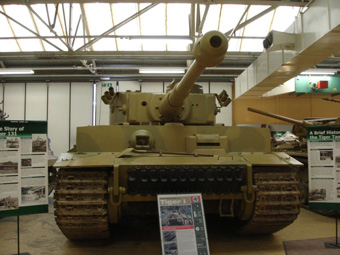By Phil Gardocki
Panzerkampfwagen Neubaufahrzeug VI
There actually were two panzers with the designation of Panzerkampfwagen VI. The first was a prewar prototype, designated Panzerkampfwagen Neubaufahrzeug (Newly Built Vehicle) VI. It sported an experimental turret that contained both a 7.5cm/L24 and a 3.7 cm/L46 gun. Two other turrets were outfitted each with a machine gun.
Six Panzer VI's seem to have been built, with three made of soft steel, and three of hard steel. The three hardened steel models were sent to Norway. One was lost in a swamp, and was replaced with a soft steel model. One source states that the 3 soft steel models were assigned to the East front, and all 3 were damaged early in the war. They were shipped back to the factory for repair, one of which was sent to Norway, while the other two were eventually scrapped.
 |
| Tiger 1 on display at Bovington Museum. |
The real Panzerkampfwagen VI, aka the Tiger, was designed in response to the large British and French tanks encountered in France, 1940. Like the Panzer III and Panzer IV, it had little or no slope to its armor. This was because most of the prewar antitank weaponry had a relatively low velocity and most medium range shots dropped in at a 10-30 degree angle anyway.
The companies of Henschel and Son and Porsche were requested to submit Panzer VI prototypes. But Dr. Porsche, because of his friendship with Hitler was so sure his model would be accepted, he started production and built around 90 before the contract was assigned to Henschel. The Porsche models were later refitted as the famous Elephant.
The first Tigers saw combat around Leningrad in 1942. A single platoon of four were engaged by the Soviets and one Tiger was captured. This caused a policy shift with the German Army never to implement any future designs in insufficient numbers. This also spurred the Soviets to develop better antitank guns which eventually lead to the T34/85 and the SU-122.
The Tiger's main failing was the difficulty of the infrastructure to transport it into theater. Most bridges could not support it's weight, so the early Tigers were designed with a snokeling package, which took time to implement. Also, the Tiger did not fit well on the rail cars, or through many rail tunnels, which required a removal of the tracks and wheels to fit.
Armed with a 8.8cm/L53 gun, which had a penetration of 12.7 cm at 2,300 meters, this cat could drop every opponent it ever faced. With 11 cm of armor, it was invulnerable to most conventional shot. At Kursk, one disabled Tiger had 72 hits on it from 7.6 cm guns before a lucky shot happened to hit an area of a previous shot. The only real tactic that consistently worked against Tigers and Panthers involved aircraft. No vehicle could take a 500 pound bomb hit, regardless of size.
The concept of the Jagdtiger began in 1942, with the decision to place a 12.8cm gun on a Tiger chassis made in 1943. While the Jagdtiger was a very formitable weapons system, it also suffered from mechanical reliability and transportation problems. In the end, only 88 were completed and assigned to independendant Panzerjagd Battalions.
| PzKpfw NbFz VI | Specification | PzKw VI Tiger I | Specification | Jagdtiger | Specification |
| Gun | 7.5cm L24 3.7cm L46 | Gun | 8.8cm L53 | Gun | 12.8cm L55 |
| Weight | 23 tonnes | Weight | 56 tonnes | Weight | 72 tonnes |
| Max Hull Armor | 2 cm | Max Hull Armor | 11 cm | Max Armor | 15cm/Hull 25cm/Gun Mantlet |
| Fuel | Gasoline | Fuel | Gasoline | Fuel | Gasoline |
| Horsepower | 300hp | Horsepower | 700hp, 515kw | Horsepower | 700hp, 515kw |
| Top Speed | 25 kph | Top Speed | 38 kph | Top Speed | 34 kph |
| Crew | 6 | Crew | 5 | Crew | 6 |
| Jagdtiger |
| As photographed by the author. Used with permission from the US Army Ordnance Museum. |
| The Panzerkampfwagen Neubaufahrzeug VI |


No comments:
Post a Comment